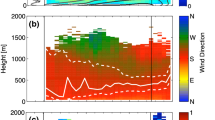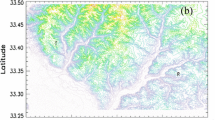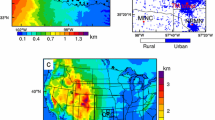Abstract
This study focuses on the inertial oscillation aspect of the nocturnal low-level jet (NLLJ). In the context of the Ekman model solutions, conceptual NLLJ inertial oscillation analytical frameworks proposed by Blackadar in 1957 and Shapiro and Fedorovich and van de Wiel et al. in 2010 are compared. Considering a NLLJ produced via direct numerical simulation over flat terrain with no baroclinic influence as a reference case, the deficiencies of each framework in representing a realistic NLLJ are assessed. The Blackadar theory results in unrealistic wind profiles near the surface. While extensions of Blackadar’s framework by Shapiro and Fedorovich and van de Wiel et al. produce more realistic NLLJs, the simpler approach taken by van de Wiel et al. does not describe the NLLJ wind hodograph at later times sufficiently in qualitative terms.






Similar content being viewed by others
References
Baas P, Bosveld F, Klein Baltink H, Holtslag A (2009) A climatology of nocturnal low-level jets at cabauw. J Appl Meteorol Climatol 48(8):1627–1642
Banta RM (2008) Stable-boundary-layer regimes from the perspective of the low-level jet. Acta Geophys 56(1):58–87
Banta R, Newsom R, Lundquist J, Pichugina Y, Coulter R, Mahrt L (2002) Nocturnal low-level jet characteristics over kansas during cases-99. Bound Layer Meteorol 105(2):221–252
Beyrich F, Kalass D, Weisensee U (1997) Influence of the nocturnal low-level-jet on the vertical and mesoscale structure of the stable boundary layer as revealed from doppler-sodar-observations. In: Acoustic remote sensing applications, Springer, New York, pp 236–246
Blackadar AK (1957) Boundary layer wind maxima and their significance for the growth of nocturnal inversions. Bull Am Meteorol Soc 38(5):283–290
Bonner WD (1968) Climatology of the low level jet. Mon Weather Rev 96(12):833–850
Ekman VW (1905) On the influence of the earth’s rotation on ocean currents. Ark Mat Astron Fys 2:1–53
Fedorovich E, Shapiro A (2009) Structure of numerically simulated katabatic and anabatic flows along steep slopes. Acta Geophys 57(4):981–1010
Geurts B (2004) Elements of direct and large-eddy simulation. RT Edwards, Philadelphia
Hoecker WH Jr (1963) Three southerly low-level jet systems delineated by the weather bureau special pibal network of 1961. Mon Weather Rev 91(10):573–582
Markowski P, Richardson Y (2011) Mesoscale meteorology in midlatitudes. Wiley, New York
Mitchell MJ, Arritt RW, Labas K (1995) A climatology of the warm season great plains low-level jet using wind profiler observations. Weather Forecast 10(3):576–591
Parish TR, Rodi AR, Clark RD (1988) A case study of the summertime great plains low level jet. Mon Weather Rev 116(1):94–105
Shapiro A, Fedorovich E (2010) Analytical description of a nocturnal low-level jet. Q J R Meteorol Soc 136(650):1255–1262
Song J, Liao K, Coulter RL, Lesht BM (2005) Climatology of the low-level jet at the southern great plains atmospheric boundary layer experiments site. J Appl Meteorol 44(10):1593–1606
Stensrud DJ (1996) Importance of low-level jets to climate: a review. J Clim 9(8):1698–1711
Van de Wiel BJ, Moene A, Steeneveld G, Baas P, Bosveld F, Holtslag A (2010) A conceptual view on inertial oscillations and nocturnal low-level jets. J Atmos Sci 67(8):2679–2689
Walters CK, Winkler JA, Shadbolt RP, van Ravensway J, Bierly GD (2008) A long-term climatology of southerly and northerly low-level jets for the central united states. Ann Assoc Am Geogr 98(3):521–552
Whiteman CD, Bian X, Zhong S (1997) Low-level jet climatology from enhanced rawinsonde observations at a site in the southern great plains. J Appl Meteorol 36(10):1363–1376
Zhong S, Fast JD, Bian X (1996) A case study of the great plains low-level jet using wind profiler network data and a high-resolution mesoscale model. Mon Weather Rev 124(5):785–806
Acknowledgements
The authors gratefully acknowledge support through the National Science Foundation (USA) Grant AGS-1359698. The authors are also grateful to anonymous reviewers for their helpful insights on the work.
Author information
Authors and Affiliations
Corresponding author
Rights and permissions
About this article
Cite this article
Smith, E., Fedorovich, E. & Shapiro, A. Comparison of analytical descriptions of nocturnal low-level jets within the Ekman model framework. Environ Fluid Mech 17, 485–495 (2017). https://doi.org/10.1007/s10652-016-9502-z
Received:
Accepted:
Published:
Issue Date:
DOI: https://doi.org/10.1007/s10652-016-9502-z




